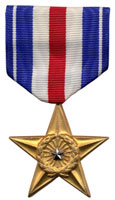*SPECIAL NOTE: This list of Silver Star recipients should not be considered complete. This is an ongoing project and we welcome information on additional Distinguished Service Cross, Silver Star, Distinguished Flying Cross, Soldier’s Medal, Bronze Star with 'V' device, ARCOM with 'V' device, and Air Medal with 'V' device recipients. Please contact us via email.
 The Citation Star was the forerunner of the Silver Star and originated in an Act of Congress approved July 9, 1918. Prior to this act, the Army had two awards for valor; the Medal of Honor and the Certificate of Merit, neither of which could be awarded by the commander in the field. Nor did the United States have a means to award and recognize gallantry or distinguished service by our allies. Upon the United States entry into WW I, it was noted that the allies effectively used awards to recognize acts of gallantry and outstanding service for those in senior positions. This prompted the United States to create additional valor awards through this act. This act created the Distinguished Service Cross for valor in combat and the Distinguished Service Medal which recognized meritorious service in positions of great responsibility. Two other important features in the act are the disestablishment of the Certificate of Merit, and the establishment of the Citation Star. The Citation Star could be awarded for gallantry in action that didn’t warrant the award of the Medal of Honor or the Distinguished Service Cross. The Citation Star could be awarded “… for each other citation of an officer or enlisted man for gallantry in action published in orders issued from the headquarters of a force commanded by a general officer, he shall be entitled to wear, as the President shall direct, a silver star three-sixteenths of an inch in diameter”. These silver stars were initially designed and worn on the WW I Victory Medal, as well as on service ribbons of campaign medals. On August 8, 1932, Congress authorized the Silver Star Medal to replace the Citation Star.
The Citation Star was the forerunner of the Silver Star and originated in an Act of Congress approved July 9, 1918. Prior to this act, the Army had two awards for valor; the Medal of Honor and the Certificate of Merit, neither of which could be awarded by the commander in the field. Nor did the United States have a means to award and recognize gallantry or distinguished service by our allies. Upon the United States entry into WW I, it was noted that the allies effectively used awards to recognize acts of gallantry and outstanding service for those in senior positions. This prompted the United States to create additional valor awards through this act. This act created the Distinguished Service Cross for valor in combat and the Distinguished Service Medal which recognized meritorious service in positions of great responsibility. Two other important features in the act are the disestablishment of the Certificate of Merit, and the establishment of the Citation Star. The Citation Star could be awarded for gallantry in action that didn’t warrant the award of the Medal of Honor or the Distinguished Service Cross. The Citation Star could be awarded “… for each other citation of an officer or enlisted man for gallantry in action published in orders issued from the headquarters of a force commanded by a general officer, he shall be entitled to wear, as the President shall direct, a silver star three-sixteenths of an inch in diameter”. These silver stars were initially designed and worn on the WW I Victory Medal, as well as on service ribbons of campaign medals. On August 8, 1932, Congress authorized the Silver Star Medal to replace the Citation Star.
The Silver Star, established by act of Congress on July 9, 1918 (amended by act of July 25, 1963), is awarded to a person who, while serving in any capacity with the Army, is cited for gallantry in action that does not warrant a Medal of Honor or Distinguished Service Cross while engaged in an action against an enemy of the United States, while engaged in military operations involving conflict with an opposing foreign force, or while serving with friendly foreign forces engaged in an armed conflict against an opposing force in which the United States is not a belligerent party. The required gallantry, while of lesser degree than that required for the award of the Medal of Honor or Distinguished Service Cross, must nevertheless have been performed with marked distinction. It is also awarded upon letter application to The Adjutant General to those individuals who, while serving in any capacity with the Army, received a citation for gallantry in action in World War I published in orders issued by the headquarters of a general officer.
World War I
World War II
Korean War
Vietnam War
Operation Urgent Fury (Grenada) and Operation Just Cause (Panama)
OIF/OEF

